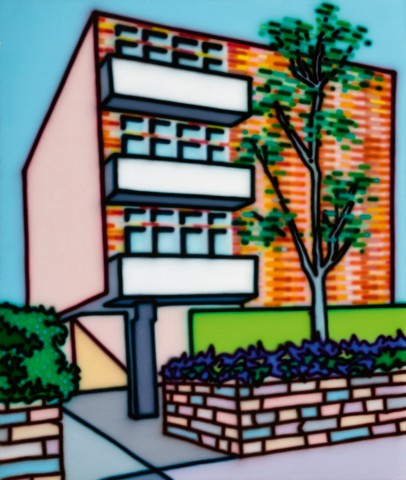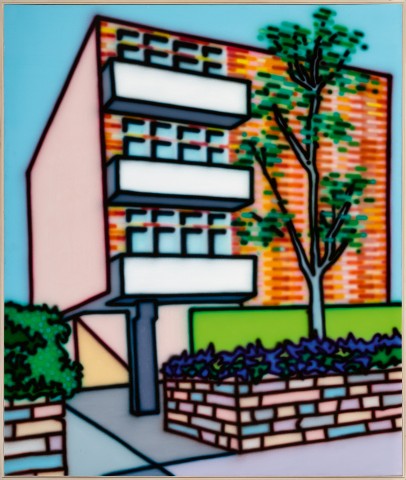O.Y.O. Flats, 1987
Howard Arkley
synthetic polymer paint on canvas
198.5 x 168.0 cm
signed, dated and inscribed with title verso: Howard Arkley / OYO FLATS / 1987
Roslyn Oxley9 Gallery, Sydney
Henry Gillespie, Melbourne
Sotheby’s, Melbourne, 2 October 1994, lot 148 (incorrectly dated as 1988)
Private collection Melbourne, acquired from the above
Private collection, Melbourne
Private collection, Melbourne, acquired from the above in 2013
Howard Arkley: Suburban Urban Messages, Roslyn Oxley9 Gallery, Sydney, 1 - 19 September 1987, cat. 3 (label attached verso, as 'OYO Flats')
The Newcastle Show Association $10,000 Invitation Art Purchase, Newcastle Region Art Gallery, New South Wales, 19 February - 13 March 1988
Downtown: Ruscha, Rooney, Arkley, Museum of Modern Art at Heide, Melbourne, 14 March – 14 May 1995
Howard Arkley, Gould Contemporary, Melbourne, 14 November – 14 December 2013
Howard Arkley and Friends, TarraWarra Museum of Art, Melbourne, 5 December 2015 – 28 February 2016
Trioli, V., 'Art in the Open Market', The Age, Melbourne, 30 September 1994, p. 11 (illus.)
Gibson, J., 'Los Melbos', Art + Text, Melbourne, no. 51, 1995, p. 21 (illus.)
Crawford, A., and Edgar, R., Spray: The Work of Howard Arkley, Craftsman House, Sydney, 2001, p. 136 (illus.)
Gregory, J,. Carnival in Suburbia, The Art of Howard Arkley, Cambridge University Press, Melbourne, 2006, fig. 2.30, pp. 20, 81, 84, 85 (illus.)
Fitzpatrick, A., and Lynn, V., Howard Arkley and Friends, TarraWarra Museum of Art, Melbourne, 2015, pp. 114 (illus.), 143
Howard Arkley Online Catalogue Raisonné: https://www.arkleyworks.com/blog/2009/11/19/o-y-o-flats-1987/ (accessed September 2025)
Modern O.Y.O. Flats, 1988, synthetic polymer paint on canvas, 180.0 x 150.0, private collection, Melbourne
Urban Apartments, 1999, synthetic polymer paint on canvas, 175.0 x 135.0 cm, private collection
1.jpg

‘Australian art has been dominated by the rural landscape, and I think there is something false and overrated – it’s romanticised or, at the very least, lopsided. Most of the population live in an urban environment. This environment affects us – the kinds of people that Australians are, and the way we behave. It affects our formative years, so it is a very important element.’1
While already a contemporary artist of note, in 1987 Howard Arkley was on the precipice of major success. Characteristically, he was working at a phenomenal pace, holding painting exhibitions in Sydney and Adelaide and a works on paper exhibition in Brisbane, as well as being included in exhibitions at the National Gallery of Victoria (twice); Heide Park and Art Gallery (now Heide Museum of Modern Art); 200 Gertrude Street (now Gertrude Contemporary); and at the University Gallery (now Ian Potter Museum of Art) and Ormond College at the University of Melbourne.2 As Arkley’s first wife, artist Elizabeth Gower observed: ‘If I had to find one word to describe Howard, it would be ‘intense’… He had a wild imagination. His conversations were intense. Whatever the subject, he’d have an opinion on it. And his most passionate subject was Art – his Art, your Art, everyone’s Art, the Art world, Art politics, good Art, bad Art. He’d thought about it all. It was Art for breakfast and Art for dinner.’3 Arkley had included paintings of suburban houses in previous exhibitions in 1983 and 19864, but his 1987 solo exhibition, Howard Arkley: Urban Suburban Messages at Roslyn Oxley9 Gallery, Sydney – which featured O.Y.O. Flats, 1987 – was the first to significantly foreground the artist’s suburban theme. Over the next decade, this subject was to fuel his reputation, and it continued to both preoccupy and fascinate him until his representation of Australia at the 48th Venice Biennale in 1999 with the exhibition The Home Show, and his untimely death in his Melbourne studio just one month later.
2.jpg

Arkley’s love of suburban design began as far back as 1978 his with photographic documentation of Australian flywire screen doors. He and Gower had recently returned from travel in Europe and New York, where they had enthusiastically analysed and sketched the patterns they had encountered ‘in everything from the Paris railway station and linoleum, to Japanese prints and the paintings of Alfred Jensen and Matisse’.5 However, for Arkley, it was these homegrown versions of Paris’ Art Deco and Art Nouveau grilles, gates and doorways that were to have the most influence, establishing a connection between the seeming banality of suburbia and the rich creative possibilities of the pattern and decoration that he found there, and went on to imagine. The artist knew the suburbs well, having grown up in Surrey Hills in Melbourne’s east (the home of another great artist of the suburban vernacular, John Brack), and having returned to live in the ‘burbs' (in Oakleigh) in 1991. Yet despite his deep commitment to the suburbs as a legitimate, meaningful and endlessly inspiring source for his art, Arkley was at once both a champion and occasional detractor of suburban life. Many of his comments defend the suburbs: ‘[t]he majority of Australians live in suburbs, but they are also cynical and embarrassed about it. They don’t see the suburbs as a subject for art, but it’s a very good way of life. There’s a barbeque in the backyard, and it’s safe for children, what’s to be embarrassed about?’6 Yet there are also glimpses in Arkley’s interviews of the realities of suburban existence for a restless, high energy artist attuned to the vicissitudes of inner-city living: ‘I actually moved out to the suburbs to get a hands-on experience… and it’s really boring. I’ve just about worn out my stay’.7 The paintings themselves remain mute on Arkley’s philosophical motivations for making them — heartfelt celebration or postmodern critique? — yet there is no denying that the artist’s sustained engagement with the suburbs made them definitively his own. As he declared:
3.jpg
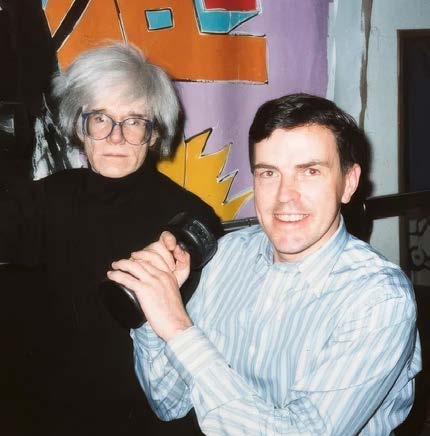
‘What I would actually like to do is the equivalent to when you’re driving along in the country and you look at the landscape and you say, ‘Oh there’s a Fred Williams.’ You change the way people see it. And you make people look at it…’8
Like many of Arkley’s suburban exteriors, O.Y.O. Flats was inspired by a real estate advertisement for the sale of a ‘LIGHT AND BRIGHT’ apartment with a ‘SUNNY OUTLOOK ON LIFE’ in Rathdowne Street, North Carlton. Using the advertisement’s fine line drawing as the starting point of his painting, Arkley transposed the composition’s tight framing and somewhat lurching perspective, as well as the viewer’s vantage point from the street – filling the open white spaces of the apartment’s original ‘likeness’ with shimmering terracotta brickwork, a tessellated fence of alternating pastel hues, and large blocks of strong colour that emphasise the building’s blocky modernist form. The artist’s command of the airbrush really comes into play here, with the work’s confident black linework emphasising the block’s solidity and ‘good bones’ (to steal a real estate term), while proudly emphasising the painting’s undeniable Pop sensibility. As Arkley happily admitted, he was ‘never ever going to be a de Kooning or a John Olsen’ and he ‘was never going to love paint and wallow around in it’9:
4.jpg
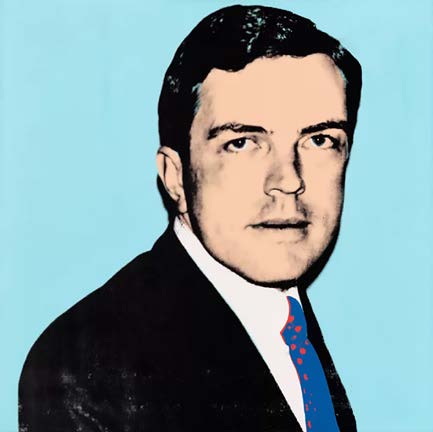
on canvas
Arts, Inc.
‘I wanted my work to look like a reproduction of a painting, not be a painting. I want it to look like it was a slide or a book. I want it to look like the paintings that educated me, and I saw them in reproduction in books and magazines and slides etc. I didn’t want any great big globules of paint running down, because in a book they don’t have that – they’re nice and flat and shiny.’10
However, despite the work’s joyous high-keyed palette and cloud-free blue sky, the ‘Own Your Own’ of Arkley’s title also points to something far less sunny: the challenges of global capitalism and the ever-diminishing Australian dream of home ownership. The modest apartments of this simple block of flats represent the aspirations of all first home buyers—the possibility of ‘owning your own’ and of getting a toehold in the market—along with the promises this brings of security and happily-ever-afters.
5.jpg
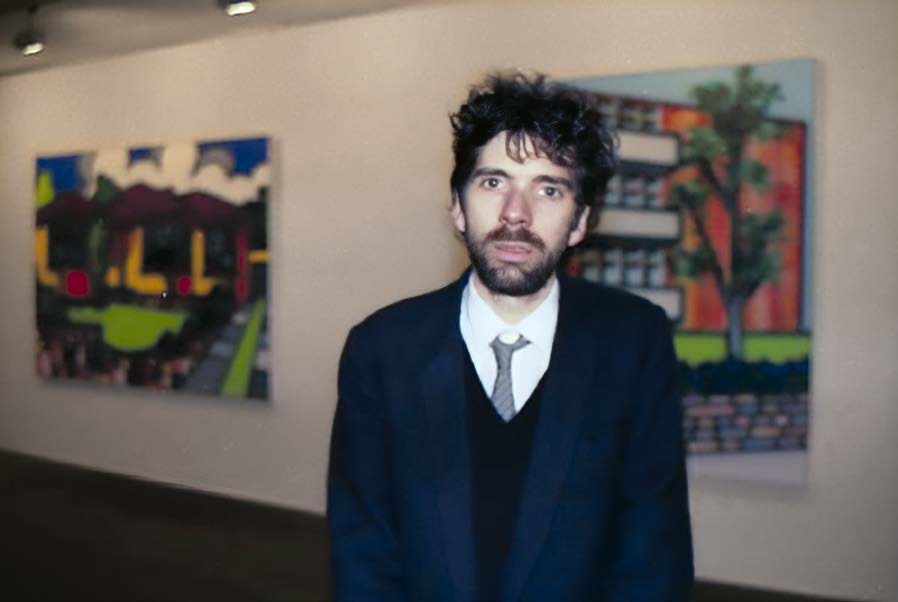
Like Andy Warhol before him, Arkley was not averse to reusing and repurposing his own imagery. The apartment block of O.Y.O. Flats may stand alone amongst the artist’s California bungalows, Spanish villas and triple-fronted brick veneer houses, but it continued to intrigue and ‘work on’ Arkley, who created two further versions: Modern O.Y.O. Flats, 1988 (with an altered perspective, different plants and a more muted palette) and Urban Apartments, 1999 (again, with altered perspective, and the replacement of the original gum with a palm tree11). It is fair to assume that the easy correspondence that O.Y.O. Flats establishes between Arkley and Warhol also resonated with the painting’s first owner, Henry Gillespie who met Warhol at a party in Los Angeles in the 1980s, later becoming the Australian editor of Warhol’s Interview magazine. He is one of only two Australians to have been painted by the artist (the other is Loti Smorgon AO) and was given one of the four portraits Warhol made of him in 1985 as payment for his work on the magazine.12 It is fitting to imagine O.Y.O. Flats in this company.
1. Howard Arkley, from an unpublished interview with the authors in Crawford, A. & Edgar, R., Spray: The Work of Howard Arkley, Craftsman House, Melbourne, 1997, p. 88
2. For a list of Howard Arkley’s exhibitions in 1987 and the works contained within them see: Gregory, J., ‘1987’, Arkley Works, at:
https://www.arkleyworks.com/blog/2009/11/20/1987/ (accessed 29 September 2025)
3. Elizabeth Gower, cited in education resource for the exhibition Howard Arkley, National Gallery of Victoria, Melbourne, 2007, at: https://www.ngv.vic.gov.au/school_resource/howard-arkley/ (accessed 29 September 2025)
4. Howard Arkley: Urban Paintings, Tolarno Galleries, Melbourne, 22 October – 13 November 1983 and Howard Akley: Recent Paintings, Tolarno Galleries, Melbourne, 20 September – 8 October 1986. Arkley also showed the interior painting Suburban, 1983 in his exhibition Howard Arkley: Recent Works (15 June – 2 July) at Roslyn Oxley9 Gallery, Sydney in 1983.
5. Brown, R., ‘Art in the Urban Environment’ in Casual Works: Working Drawings, Source Material, Doodles 1974 – 1987, 200 Gerturde Street, Melbourne, 1988, unpaginated, cited in Fitzpatrick, A., ‘Sampling: The Art of Howard Arkley’, Howard Arkley and Friends, TarraWarra Museum of Art, Healesville, 2015, p. 12
6. Gardner, K., Australia at the Venice Biennale: A Century of Contemporary Art, The Miegunyah Press, Melbourne, 2021, p. 132
7. Howard Arkley, cited in Barclay, A., ‘Mobile Message’, Herald Sun, 16 August 1996, cited in Gregory, J., Carnival in Suburbia: The Art of Howard Arkley, Cambridge University Press, Melbourne, 2006, p. 10
8. Howard Arkley, from an unpublished interview with the authors, Crawford, A. & Edgar, R., Spray: The Work of Howard Arkley, Craftsman House, Melbourne, 1997, p. 89
9. Howard Arkley, cited in Wyzenbeek, T. (dir.), Howard’s Way, ABC-TV Arts, 1999
10. ibid.
11. This work was shown in the artist’s first international commercial exhibition: Howard Arkley: Home Show, Karen Lovegrove Gallery, Los Angeles, 9 July – 14 August 1999. According to John Gregory, the exhibition was a sell-out: Gregory, J., ‘‘Howard Arkley: Home Show’, Karyn Lovegrove Gallery, Los Angeles, Jul-Aug 1999’, Arkley Works, at:
https://www.arkleyworks.com/blog/2009/11/20/1987/ (accessed 1 October 2025)
12. Wall label, Andy Warhol and Photography: A Social Media, Art Gallery of South Australia, Adelaide, 3 March – 14 May 2023, at: https://www.agsa.sa.gov.au/collection-publications/collection/works/henr... (accessed 1 October 2025). The portrait that belonged to Gillespie was acquired by the Art Gallery of South Australia in 1996; the remaining three are in the collection of the National Gallery of Australia.
KELLY GELLATLY
